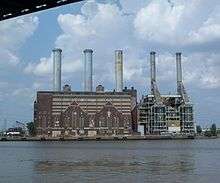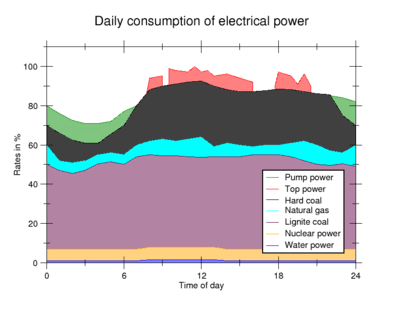Peaking power plant

Peaking power plants, also known as peaker plants, and occasionally just "peakers," are power plants that generally run only when there is a high demand, known as peak demand, for electricity.[1][2] Because they supply power only occasionally, the power supplied commands a much higher price per kilowatt hour than base load power. Peak load power plants are dispatched in combination with base load power plants, which supply a dependable and consistent amount of electricity, meeting the minimum demand.
Peak hours
Peak hours usually occur in the morning or late afternoon/evening depending on location. In temperate climates peak hours often occur when household appliances are heavily used in the evening after work hours. In hot climates the peak is usually late afternoon when air conditioning load is high, during this time many workplaces are still open and consuming power. In cold climates the peak is in the morning when space heating and industry are both starting up.[3]
A peaker plant may operate many hours a day, or it may operate only a few hours per year, depending on the condition of the region's electrical grid. Because of the cost of building an efficient power plant, if a peaker plant is only going to be run for a short or highly variable time it does not make economic sense to make it as efficient as a base load power plant. In addition, the equipment and fuels used in base load plants are often unsuitable for use in peaker plants because the fluctuating conditions would severely strain the equipment. For these reasons, nuclear, geothermal, waste-to-energy, coal and biomass are rarely, if ever, operated as peaker plants.

Renewable Energy
For countries that are trending away from coal fired baseload plants and towards intermittent energy sources such as wind and solar, there is a corresponding increase in the need for peaking or load following power plants and the use of a grid intertie.
Types
In the US peaker plants are generally gas turbines that burn natural gas. A few burn petroleum-derived liquids, such as diesel oil and jet fuel, but they are usually more expensive than natural gas, so their use is limited. However, many peaker plants are able to use petroleum as a backup fuel. The thermodynamic efficiency of simple-cycle gas turbine power plants ranges from 20 to 42%, with between 30 to 42% being average for a new plant.
For greater efficiency, a heat recovery steam generator (HRSG) is added at the exhaust. This is known as a combined cycle plant. Cogeneration uses waste exhaust heat for process or other heating uses. Both of these options are used only in plants that are intended to be operated for longer periods than usual. Natural gas and diesel generators with reciprocating engines are sometimes used for grid support using smaller plants.
Another option for increased efficiency and power output in gas turbines is installing a turbine inlet air cooling system, that cools down the inlet air temperature increasing mass flow ratio. This option in combination with a thermal energy storage tank, can increase the turbine power output in on-peak periods up to 30%.[4]
Pumped-storage hydroelectricity is the largest-capacity form of grid energy storage available, used for averaging off peak and peak electrical demands. The site stores energy using the gravitational potential of water stored in a reservoir. Low-cost off-peak electric power is used to pump water at a low elevation to storage in a high elevation reservoir. During periods of high electrical demand, the stored water is released through turbines to produce electric power. Start up times are only a few minutes.
Hydroelectric Dams are variable; they can generate less during off-peak and quickly respond to peak demands. Hydroelectricity can function as baseload and a peaking plant. Gas turbines and pumped storage are used where a dam large enough to supply the peak load is unavailable.
Base load power plants
The opposites of peaking plants are base load power plants. Nuclear and coal burning plants operate continuously, stopping only for maintenance or unexpected outages. Intermediate load following power plants such as hydroelectric operate between these extremes, curtailing their output on nights and weekends when demand is low. Base load and intermediate plants are used preferentially to meet electrical demand because the lower efficiencies of peaker plants make them more expensive to operate.[5]
See also
- Base load power plant
- Geothermal electricity
- List of energy storage projects
- Smart grid
- Vehicle-to-grid
- Turbine Inlet Air Cooling
- Load following power plant
References
- ↑ Renewable and Efficient Electric Power Systems by Gilbert M. Masters
- ↑ http://www.opc.com/PoweringGeorgia/TypesofPowerPlants/PeakingPlants/index.htm
- ↑ https://books.google.ca/books?redir_esc=y&id=M0EnqtFxW3cC&q=peak+time#v=snippet&q=peak%20time&f=false pg 284
- ↑ Kamal NA, Zuhair AM (2006). Enhancing gas turbine output through inlet air cooling. Sudan Eng. Soc. J., 52(4-6): 7-14.
- ↑ http://www.opc.com/PoweringGeorgia/TypesofPowerPlants/BaseAndIntermediatePlants/index.htm